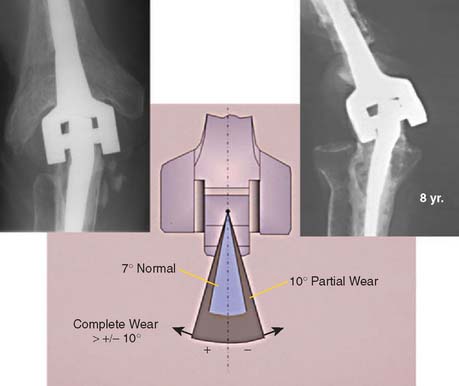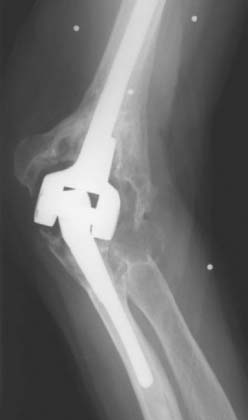CHAPTER 64 Wear and Elbow Replacement
INTRODUCTION
Over the past decade, the reliability and success of total elbow replacement surgery has become more established. The durability of total elbow arthroplasty (TEA) for rheumatoid arthritis is now similar to that of hip replacement.2 Indications have also expanded to include the full spectrum of traumatic conditions: distal humeral nonunion,9 instability,10 ankylosis,7 established arthritis,11 and acute intra-articular, comminuted fractures in selected older patients.4,5
Until recently, wear of the polyethylene articulating surface had not been recognized as a problem or addressed in the literature. Although this may not be a practical concern in unconstrained and unlinked designs, wear of the articular polyethylene bushings in linked, semiconstrained designs is a potential issue, particularly with the evidence of the increasing longevity and improved function that these designs now have, resulting in increased use of the limb. Until recently, this specific topic has not been considered when complications with TEA are being discussed.3 This chapter focuses on our experience with the problem as the development requires or implies long-term stable fixation. Hence, there has been little in the literature regarding this problem with other designs.
To address this issue, we reviewed the Mayo Clinic experience with reoperations to exchange worn bushings in the linked, semiconstrained Coonrad-Morrey TEA. Twelve of 919 TEAs reviewed (1.3%) had undergone isolated bushing exchange for wear.6 An additional six patients were diagnosed as having bushing wear on the basis of an asymmetric anteroposterior orientation of the ulnar component within the humeral yoke, although these patients did not have a revision.
CLINICAL AND RADIOLOGIC FEATURES
Pain, crepitus and squeaking sounds are the most common presenting features of articular bushing wear. Loss of range of motion is not marked, and there are no symptoms of functional instability or weakness. In our experience, the patients with post-traumatic arthritis had a higher prevalence of bushing wear (seven of 294; 2.4%) than did those with rheumatoid arthritis (five of 377; 1.4%).6
Radiographic assessment is conducted before the total elbow replacement to identify deformity and after replacement to identify signs of bushing wear, osteolysis and status of the implant. The criteria for the assessment of wear were described by Ramsey et al.10 Anteroposterior plain radiographs of the elbow in full extension made following the index arthroplasty and at the time of bushing exchange are compared. The prosthesis was designed with 7 to 10 degrees of varus-valgus laxity. A line is drawn parallel to the yoke of the humeral component, and another line is drawn parallel to the medial or lateral surface of the articular surface of the ulnar component. An angle of intersection of more than 7 degrees between these two lines indicates alteration of the bushing due to wear or plastic deformation. An angle of more than 10 degrees is considered to indicate mild to moderate bushing wear (Fig. 64-1). Of importance is that none of our patients experienced loosening of the implant because of wear. It must be emphasized the extensive osteolysis seen in the past around the ulnar component was related to osteolysis caused by loosening of a “precoat” ulnar surfaced component. These devices were implanted between 1994 and 2000. Some have confused this appearance as being caused by wear. As in the hip the proper interpretation is the implant becomes loose and the particulars associated with this are termed accelerated bushing wear (Fig. 64-2). Typically bushing wear, even when excessive, causes local osteolysis, but not implant loosening (Fig. 64-3).










